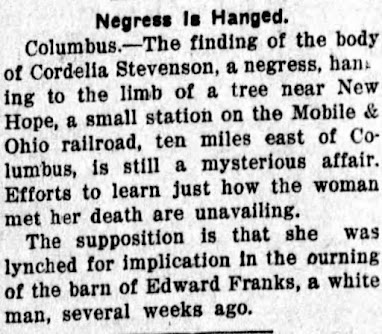Dec. 30, 1923, the assault, and murder of a white woman in the community of Catcher, Crawford County in Arkansas ignited a race riot. The riot was spread out over a few days, but the ramifications are still felt nearly 100 years later
On Dec. 28, Effie Latimer was shot in the back and hit over
the head with the gun. Latimer, a 25-year-old white woman, was found
unconscious on the ground when a friend came to visit her that afternoon.
She gained consciousness long enough to tell a doctor that she recognized
her shooter as Son Bettis, a local African American farmer, adding two other
men were present, though she was not able to identify them.
According to several newspaper accounts, it was in fact the
doctor who gave the identity of the supposed “Negro” attacker, and he was the
last to see Latimer alive. The prime suspect a Black farmer named Son Bettis stated
he was innocent and picking cotton on his land near Van Buren 4 miles south.
There is reason to believe Bettis had nothing to do with the assault as Mrs.
Latimer’s husband had left her the week before and had taken half of their
belongings. It was known they had a troubled marriage.
Bettis was arrested that afternoon and two more men were
arrested. Charles Spurgeon Rucks Jr., 26, and John Henry Clay, 14, the next day.
At this time Deputy Sheriff W. A. Bushmaier Jr. said he received a confession
from Rucks, but Rucks stated Bushmaier lied while in court. Bushmaier did have
the sense to have the men taken to Fort Smith and then Little Rock.
On Dec. 29 an angry white mob of more than 500 white citizens
surrounded the jail at Fort Smith, demanding that the prisoners be handed over
to them. Many others were running the Catcher and Van Buren roads threatening
black residents, smashing tombstones in the black cemetery, and digging up
remains of the deceased and burning them.
On December 30 the situation completely exploded in violence
when Rucks's father was shot and killed by Deputy Sheriff Frederick Creekmore.
Also, 11 other Black men were arrested for “Night Riding” and threatening whites.
The mob that had been seeking blood spent their time
assaulting Black farmers and making threats. At least 40 families left their
homes and land in Catcher and made their way to Van Buren and other towns west
and east.
The mass exodus seemed to end on the 31st when no Blacks other
than those arrested could be found in Catcher.
Son Bettis and Spurgeon Rucks Jr were convicted and sentenced
to die in the electric chair, they were executed on June 27, 1924. Clay was sentenced
to life in prison; on August 16, 1928, he was found dead from exposure in a
field near one of the prison camps at Cummins.
Catcher quickly became another “Sundown Town” where a Negro found
within the city limits after sundown would be arrested, possibly shot. Van Buren
has one of the higher African American populations in Arkansas.
Photo: murder victim Effie Latimer, suspects Spurgeon Rucks Jr. and Son Bettis
Sources:
https://www.swtimes.com/story/news/2021/06/18/1923-race-riot-catcher-arkansas-led-exodus-black-families/7626544002/
https://encyclopediaofarkansas.net/entries/catcher-race-riot-of-1923-5885/
https://blackthen.com/assault-murder-sparked-catcher-race-riot-1923/





























